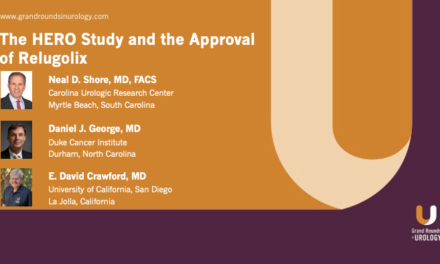James A. Eastham, MD, FACS, presented “Active Surveillance in Favorable Intermediate-Risk Prostate Cancer” during the 31st International Prostate Cancer Update in July 2021 in Snowbird, Utah.
How to cite: Eastham, James A. “Active Surveillance in Favorable Intermediate-Risk Prostate Cancer.” July 2021. Accessed Jul 2024. https://grandroundsinurology.com/active-surveillance-in-favorable-intermediate-risk-prostate-cancer/
Active Surveillance in Favorable Intermediate-Risk Prostate Cancer
James A. Eastham, MD, FACS, the Peter T. Scardino Chair in Oncology and Chief of the Urology Service in the Department of Surgery at Memorial Sloan-Kettering Cancer Center in New York, discusses the process of selecting intermediate-risk patients with prostate cancer for active surveillance (AS). He explains how active surveillance serves as an alternative to direct treatment that helps reduce cases of overtreatment, and notes that it is now considered an option for intermediate-risk (IR) patients across many guidelines. However, no process for patient selection is outlined, despite evidence that AS used indiscriminately with all IR patients is harmful. Dr. Eastham cites the PIVOT, ProtecT, and PREFERE trials, all of which show that when looking at the IR population as a whole, treatment is preferred based on increased rates of survival and decreased rates of disease progression. He raises the question of why AS is recommended for such patients when this data exists and summarizes the results of 14 series’ on AS for men with favorable IR compared to low-risk (LR) patients, finding equivalent survival rates in the two groups with estimated metastasis-free survival and prostate cancer-specific survival of 90% at 15-year follow up. Despite these positive results, Dr. Eastham states that there is no set definition of a “favorable” IR patient and looks to more trials to fill in this gap. He summarizes data from Göteborg and Sunnybrook, with Göteborg’s cohort showing 90% prostate cancer-specific survival and Sunnybrook’s showing 89%. Dr. Eastham details how Sunnybrook’s data includes information on Gleason pattern 4 being a major driver of high rates of metastases, leading him to then look at data from the Martini Klinik, the University of Michigan, and Memorial Sloan Kettering Cancer Center supporting the idea that choosing patients with lower volume of Gleason pattern 4 will lead to greater success of AS in IR patients.
About The 31st Annual International Prostate Cancer Update:
The International Prostate Cancer Update (IPCU), founded in 1990, is a multi-day CME conference focused on prostate cancer treatment updates with expert, international faculty. It is led by expert physicians and is designed for urologists, medical oncologists, radiation oncologists, and other healthcare professionals involved in the diagnosis and treatment of prostate cancer. Dr. Eastham delivered this educational activity during the 31st iteration of the meeting in July 2021 in Snowbird, Utah.
ABOUT THE AUTHOR
James A. Eastham, MD, FACS, is the Peter T. Scardino Chair in Oncology and Chief of the Urology Service in the Department of Surgery at Memorial Sloan-Kettering Cancer Center in New York. Dr. Eastham received his medical degree from the University of Southern California, Los Angeles. He completed an Internship in General Surgery and a Residency in Urology at Los Angeles County+USC Medical Center. He went on to complete a Fellowship in Urologic Oncology at Baylor College of Medicine in Houston, Texas. Prior to his appointment at Memorial Sloan-Kettering Cancer Center, Dr. Eastham was an Assistant and Associate Professor in the Department of Urology at Louisiana State University in Shreveport and Chief of Urology at Overton-Brooks Veterans Administration Medical Center in Louisiana.
Dr. Eastham’s research has focused on the prevention and treatment of prostate cancer, and he has a particular interest in improving oncologic and quality-of-life outcomes after radical prostatectomy. He has authored or co-authored over 300 articles which have appeared in peer-reviewed journals such as the Journal of the American Medical Association, the Journal of Urology, the Journal of Clinical Oncology, Urology, and Transplantation. In addition, he has authored numerous book chapters, reviews, monographs, and abstracts. He is a Fellow of the American College of Surgeons and a member of several professional societies, including the American Urologic Association, the Society of Urologic Oncology, and the Societé Internationale D’Urologie.




